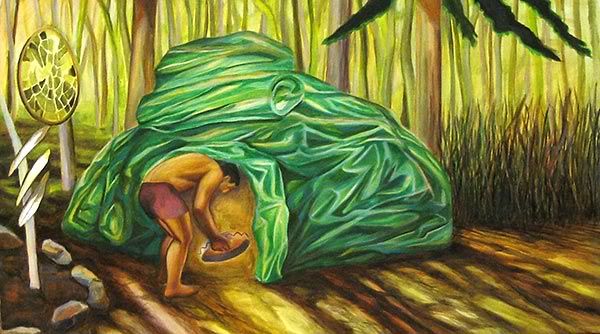
From Luxton Museum of the Plains Indian:
The Sweat Lodge ceremony practiced by the Peoples of the Plains was a physical and spiritual purification. It was used to meditate, to prepare for other ceremonies, or to answer important questions. The ceremony combined the elements of fire, wood, water and stone. The Sweat Lodge was a dome-like tent made from fresh cut willow branches and covered with hides and blankets. A round pit was dug in the center. There was always a leader and a fire keeper in the ceremony. The leader was the teacher of the ceremony and the fire keeper had many different responsibilities.
The ceremony would begin with the participants entering the sweat lodge in a clockwise direction. The rocks (which had been heating outside) were brought into the lodge by the fire keeper and placed into the center pit by the leader. The door to the sweat lodge was closed and the interior heated up like a sauna. The ceremony consisted of four rounds of prayers, spiritual songs, and drumming. As the participants prayed, the leader threw water and herbs on the heated rocks. Sweet grass was burned and pipes were smoked as offerings to the Spirits. After the ceremony was finished the participants exited in a clockwise direction and lay on the grass to cool their bodies. An expression often heard describing the sweat lodge was that you emerged 'feeling like a new born baby'. This comes from the belief that the Sweat Lodge had the spiritual powers and feelings of a woman's womb.
Sweat Lodge ceremonies are still practised today by Natives and non-Natives alike. It is still an important ceremony for spiritual and physical cleansing. The ritual may be practiced once or twice per lunar cycle, and benefits from the sweat are often experienced in a cumulative progression.
Physical Benefits
 Sweating rids the body of wastes. In this modern sedentary age of pollution, artificial environments, synthetic clothing and lack of regular exercise, a sweat bath can open clogged skin pores and stimulate the healthy flow of a body's own natural sweat.
Sweating rids the body of wastes. In this modern sedentary age of pollution, artificial environments, synthetic clothing and lack of regular exercise, a sweat bath can open clogged skin pores and stimulate the healthy flow of a body's own natural sweat.
Depending on how hot the sweat bath is and the climate in which it occurs, a fifteen minute sauna or sweat can perform the heavy metal excretion that normally takes healthy kidneys 24 hours to accomplish. Body sweat flushes toxic metals such as copper, lead, zinc, and mercury from the body. A sauna is often recommended as a supplement to kidney machines. Sweat can also remove excessive salts; this is generally believed to be beneficial for cases of mild hypertension. Sweat can also eliminate urea, a metabolic by-product. Excessive urea can cause headaches, nausea and in extreme cases, vomiting, coma—even death. Sweat may also draw out lactic acid responsible for stiff muscles and a contributor to general fatigue.
Lungs benefit, too. Clogged respiratory passages are opened by heat; this gives relief from colds or minor respiratory problems. Sweat baths are not recommended for persons with pneumonia and major respiratory problems. The heat of a sweat bath and the often rapid cooling afterwards, conditions the body. A well-tuned body is more resistant to colds, disease and infection. In cold weather, a warm glowing feeling often lingers for hours following a sweat bath. In hot weather, the body seems cooler afterwards.
Spiritual Aspects

Examining important elements used in the Native American sweat lodge sheds light on its spiritual benefits. First, is the "symbolic" lodge itself. The lodge is often built (or renewed) during the morning of the chosen "Sweat Day." People fast while working on the lodge to help their intent remain focused, pure. Prayer is offered as willow or other saplings are cut, as holes are dug for the placement of saplings and as the pit for the hot rocks is excavated. Tobacco, a powerful herb now commonly misused, is often used for offerings—a visible "amen" to prayer. Such lodges can be, and often are, a portal for communication with a Higher Power, the Creator; it is very necessary to exercise care and good intent in all things connected with a sweat lodge, its construction and its rites.
Willow, it seems, is universally preferred for Sweat Lodge construction by most Native American groups. Words from Bobby Woods, Sioux sweat leader, illustrates some of the many symbolic attributes associated with willow. "Willow branches used to construct the lodge also taught bathers a lesson. In Fall, leaves of the willow died and returned to earth... in Spring, they come to life again. So too, men died but lived again in the real world of Creator where there is nothing but the eternal spirits of deceased things. A foretaste of this true life could be known here on Earth if they purified their bodies and minds, thus coming closer to the Great Spirit who is All-Purity....." Also, according to Bobby, the willows used in the lodge were set up in such a way as to symbolically mark off the four quadrants of the universe—everything of the world and sky was represented within the framework. The relationship of all things is visible here.
The sacred elements fall into play in the ceremony. For each element that is honored in the particular ceremony, the lodge will be steamed then briefly vented. Oftentimes the final round of heat will introduce a peak in temperature, since during the venting more hot air stays trapped than gets mixed with cooler incoming outside air. By this method the participants are tempered by the vaporous bath in stages.
- Sweat Lodge: A how to guide
- Graphics:Andy Everson